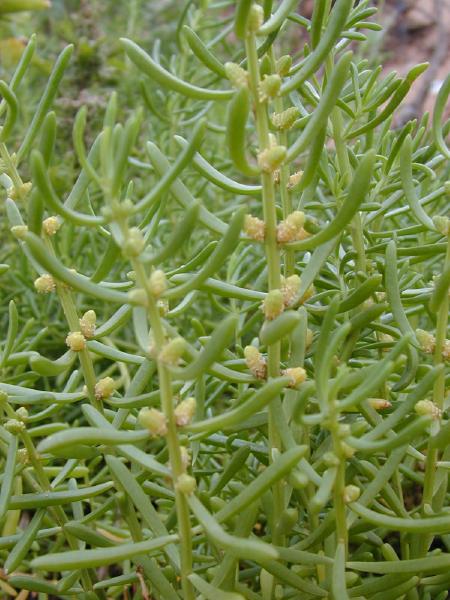- Batis
Taxobox
name = "Batis"

image_caption = Male flowers on "Batis maritima"
regnum =Plantae
unranked_divisio =Angiosperms
unranked_classis =Eudicots
unranked_ordo =Rosids
ordo =Brassicales
familia = Bataceae
genus = "Batis"
genus_authority = L.
subdivision_ranks = Species
subdivision = "B. argillicola" "B. maritima""Batis" (Turtleweed, Saltwort, Beachwort, or Pickleweed) is a genus of two species of
flowering plant s, the only genus in the family Bataceae. They are halophytic (salt tolerant) plants, native to the coastalsaltmarsh es of warm temperate and tropical America ("B. maritima") and tropicalAustralasia ("B. argillicola").Both species are
evergreen lowshrub s growing to 10-70 cm tall, prostrate where colonizing new mud, but once rooted, growing bushy. The leaves are small, swollen, fleshy and narrowly club-shaped. They are bright green, but can also take on a reddish color. Theflower s are small, produced in nonshowy spikes, flowering from mid summer to fall. The American species is dioecious, while the Austalasian species is monoecious.Some
botanist s divide "B. maritima" into five species, with "B. californica", "B. fruticosa", "B. spinosa" and "B. vermiculatus" split off, but this interpretation is not widely followed."Batis" has the ability to live in salty environments. When other plants are exposed to salty soil or water, they lose most of their stored water, but "Batis" has adapted to this environment and does not have these problems. To help it survive in this salty habitat, its fleshy leaves are covered with very fine hairs that reduce the amount of water the plant loses to the air.
Not many animals can eat it because it is too salty, but
White-tailed Deer eat "B. maritima" as part of their diet. Eastern Pygmy-Blue butterflies collect thenectar from its flowers. "B. maritima" is becoming rare in some areas, and some scientists think it should be added to theUnited States endangered species list, though it has also become aninvasive species inHawaii after accidental introduction there.The genus "
Salsola " is also sometimes known as Saltwort, but is unrelated.Uses
"B. maritima" was used by Native Americans as a food, the
root s were chewed (likesugar cane ) or boiled into a beverage while the stems and leaves were eaten raw, cooked or pickled. "B. argillicola" is also eaten as a green vegetable.Saltwort has unexpectedly turned out to be a nutritious food source. An analysis of its peppercorn-sized
seed s has revealed that they are extremely nutritious, having high quantities ofprotein s, oils andstarch es [http://www.eurekalert.org/pub_releases/2002-09/ns-sto092502.php] . According to Massimo Marco from an article published byNew Scientist , theseed s are extremely edible, having a nutty taste, and they can be added tosalad s, toasted, or even made into miniaturepopcorn . The oil is almost identical tosafflower oil , which is used for cooking and in salad dressings, as well as for makingmargarine . The seeds also contain beneficial antioxidants such as tocopherols, which are thought to fight cancer.References
* [http://plants.usda.gov/java/profile?symbol=BAMA5 "Batis maritima" USDA plant profile]
* [http://florabase.calm.wa.gov.au/browse/flora?f=081&level=s&id=1743 "Batis argillicola" in Flora of Western Australia]
* [http://www.eurekalert.org/pub_releases/2002-09/ns-sto092502.php Article on the studies done on Saltwort by Massimo Marcone] . It was originally published at newscientist.com: [http://www.newscientist.com/article.ns?id=mg17523622.000]
* [http://www.biosalinity.org/salt-tolerant_plants.htm Listing of Halophytes & Salt-Tolerant Plants]
Wikimedia Foundation. 2010.
